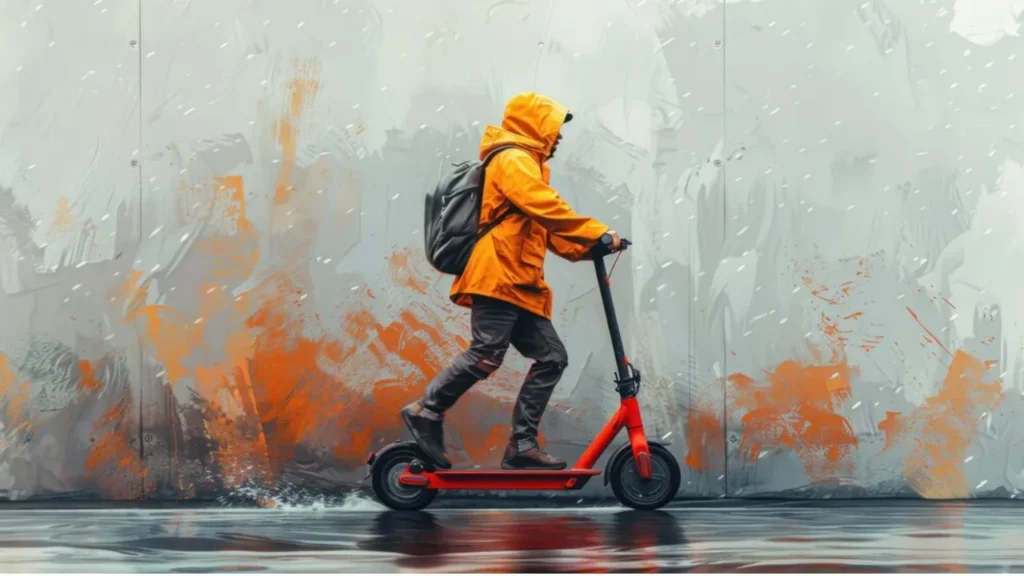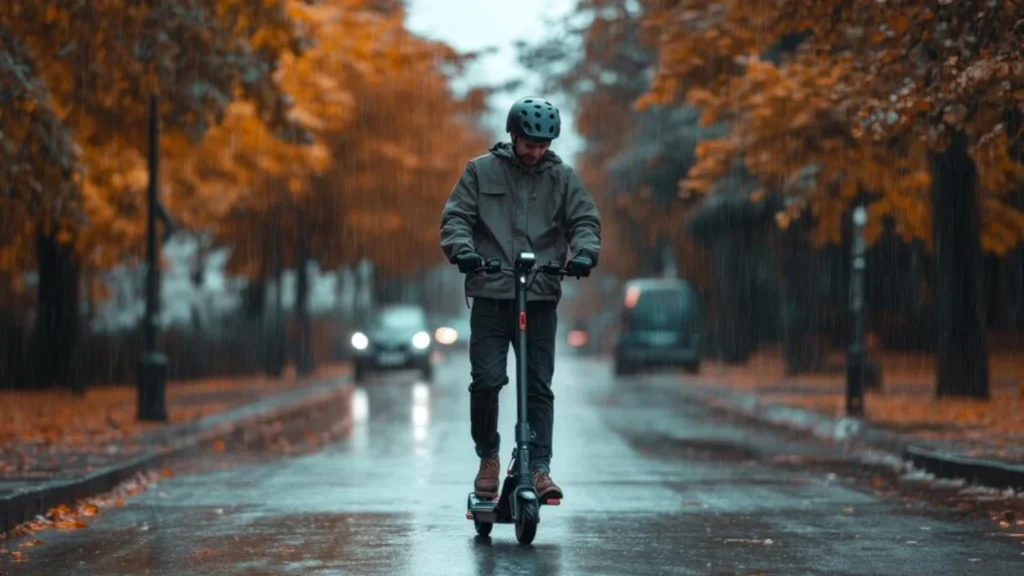Let’s be honest: when I wonder, “Can you ride an electric scooter in the rain?” it raises a few eyebrows—and some serious questions. Is it safe? Is it really a smart idea? Or am I just one puddle away from ruining my scooter?
Riding in the rain isn’t just about staying dry; it’s also about safety, keeping your scooter in good shape, and avoiding that awkward moment of sliding halfway across town.
So, if you’re tempted to roll out on a rainy day, here’s everything you need to know!
Can You Ride an Electric Scooter in the Rain?
Absolutely, you can ride an electric scooter in the rain, but it’s best to stick to light rain and take some precautions.
First things first: check your scooter’s water resistance rating. This will tell you how well it can handle wet conditions and help keep you safe while riding in the rain.
If you’re curious about how to stay safe out there when the weather turns, keep reading!

What is an IP Rating?
So, let’s talk about IP ratings, which are super important when it comes to your electric scooter. An IP (Ingress Protection) rating tells you how well your scooter can resist dust and water.
The rating has two digits: the first one shows how well it keeps out solid particles, and the second one rates its moisture resistance. Basically, the higher the numbers, the better the protection!
This rating gives you a clear idea of how much water your scooter can handle before things start getting a bit dicey with the electronics. So, knowing your scooter’s IP rating is key to staying safe and keeping it in good shape!
If your scooter has an IP rating of IP54, it can handle light rain but might struggle in a heavy downpour.
And just a quick reminder—there’s a big difference between “water-resistant” and “waterproof.” When something is labeled “waterproof,” it means it can handle a brief rain shower, not that it can survive a swim in the river! If your scooter doesn’t have any IP rating at all, it’s best to skip riding in the rain altogether.
Risks of Riding an Electric Scooter in the Rain
Riding in the rain might sound exciting, but there are a few things to keep in mind:
Safety First: Wet roads can be slippery, which means longer braking distances and poor visibility.
Technical Risks: Plus, there’s the chance of moisture getting into your scooter’s motor or battery, turning your ride into a risky gamble.
Reality Check: Let’s be real—scooter tires aren’t exactly designed for slick surfaces, and braking in the rain can be a bit nerve-wracking.
Now, am I saying you should freak out and never ride your scooter again if you see some gray clouds? Not at all!
But you definitely want to do a quick weather check and make sure you’re prepared before heading out.
So, here’s what you need to keep in mind!
- Also Read: Segway Ninebot P65 Review
Pre-Ride Checklist for Rainy Conditions
Thinking about taking your scooter out in the rain? Before you hit those wet streets, here’s a quick checklist to make sure you and your scooter are ready for the challenge.
Check the IP Rating: Not all scooters can handle a good soaking. If your scooter doesn’t have an IP rating, it’s best to skip the rain altogether to avoid a soggy ride that could short-circuit your electronics.
Inspect Tire Tread and Condition: Wet roads can be super slippery, so make sure your tires have solid tread. Good grip means you’ll stay upright, so check that they aren’t slick or worn down.
Give Your Brakes a Test Squeeze: Wet brakes can be a bit sluggish. Give them a squeeze and listen for any weird sounds to make sure they’re in good shape. You want them working well when it’s time to stop!
Waterproof Jacket or Bust: Getting soaked is no fun. A good waterproof jacket will keep you warm and help you avoid that “drowned rat” look.
Upgrade Your Helmet Visibility: Rain can mess with visibility, so make sure your helmet has some reflective tape or a clip-on light. You want to be seen!
Add Extra Lighting or Reflective Gear: In rainy weather, being visible is key. Whether it’s reflective tape or extra lights on your scooter, do whatever it takes to stand out to drivers.
Ready to roll? Stay dry and keep it safe out there!

Tips for Riding Safely in the Rain
If you’re set on riding in the rain, here’s how to keep yourself out of trouble and avoid any wipeouts:
Slow it Down: Rain changes everything when it comes to braking. You’ll need more time to stop, so ease up on the speed and give yourself extra space to brake.
Steer Clear of Puddles: Puddles can be sneaky—they might hide potholes or debris underneath. If you see one, treat it like a trap and steer around it!
Watch Out for Painted Lines and Metal: Anything that’s painted or made of metal can turn into a slippery surface when wet. Crosswalks, manhole covers, and construction plates are all like ice patches—so be careful!
If you keep these tips in mind, you’ll be able to ride through the rain with way less drama!
- Also Read: How to Reset Electric Scooter?
What to Do After Riding in the Rain
So, you’ve braved the rain and lived to tell the tale—good for you! Now, let’s wrap things up with some essential post-rain care for your scooter:
Dry It Off: Make sure to dry off your scooter, especially the battery and motor. Moisture in these areas can lead to rust and electrical issues. Just grab a towel and make sure everything is nice and dry to keep your scooter happy.
Store It in a Dry Spot: Think of your scooter like a wet dog. Towel it off and give it a cozy, dry place to chill instead of leaving it somewhere damp to “air dry.”
Do a Quick Check for Odd Sounds or Wear: Water exposure can cause weird creaks or early wear. A quick inspection after riding in the rain can help you spot any issues before they turn into costly repairs.
Keep these tips in mind, and your scooter will be ready for your next adventure!
Final Words
So, here’s the deal: if it’s just drizzling and your scooter has the right IP rating, you might be good to go. But when it comes to heavy rain? Not worth the risk unless you’re feeling lucky and don’t mind potentially damaging your scooter.
Trust me, I’ve been in some tricky situations—you really don’t need to prove anything here.
A little rain? Sure, that’s manageable. But a downpour? Just skip it and stay dry!